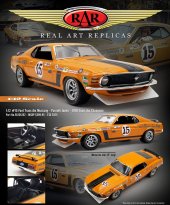RACING | HISTORY | PASSION
ISSUE #24
COVER STORY
Formula 1 Season 1970
The 1970 season in numbers
A dramatic new beginning – Entering the third decade of Formula 1
Full of surprises – The first phase
The summer of Jochen Rindt – The second phase
The reluctant chase – The third phase
Lotus 72 – The most successful Formula 1 car of the 1970s
‘I could talk to the car, and the car talked to me’
– Interview with Emerson Fittipaldi
A dramatic new beginning
Entering the third decade of Formula 1
Fifty years ago Formula 1 produced a memorable season, with highs and lows like few others. There was remarkable diversity thanks to five new manufacturers and a total of 38 drivers. Seven of those drivers, from five different teams and powered by three different engines, shared the 13 race wins – more than ever before. There was also an unwavering sense of drama from June onwards. Motorsport was unbelievably dangerous at the time. Three established, top-level drivers were killed during the 1970 season – including the championship leader. In December the FIA awarded the world championship posthumously for the first, and fortunately so far only, time.
In the midsummer of 1970, German Jochen Rindt, racing under an Austrian licence, hit the peak of his career. After a series of four consecutive wins in his revolutionary Lotus 72, the last coming on home soil at Hockenheim where he kept the ever-increasing number of Ferraris in check, the 28-year-old held a commanding championship lead. At his second home race at the Österreichring in mid-August – just an hour from Graz, where he had grown up with his grandparents after the death of his parents – the Austrians celebrated him as their superstar. Rindt’s face adorned the cover of the September issue of German motorsport magazine sport auto.
Three weeks later, on 5 September, Rindt was killed in a devastating practice crash at Monza. Over the four races that followed to close out the season, nobody was able to run down his points tally. On 12 December his widow Nina accepted the trophy from FIA president Prince Paul Alfons von Metternich in Paris in Rindt’s place…
by Harold Schwarz
Photographs: Cahier, Motorsportimages, Kräling, Collection Robert Weber/Toni Temburg
The reluctant chase
The third phase
Ferrari was outstanding across the second half of the season, with four wins (three of them one-twos), a second and a fourth place (the latter not counted, as it was a dropped result). It yielded 42 constructors’ points, 24 more than Lotus, who were the second-best team during this final phase with two wins. However, the reds’ charge came too late – which was arguably for the better, because if anyone had overtaken Rindt in the standings after the German’s fatal accident at Monza, it probably would have left a rather bitter aftertaste.
Looking back, Ferrari had wasted its shot at the title in the first half of the season by fielding only a single car that was then continually hampered by problems. It wasn’t until the French Grand Prix, the sixth round, that the 12-cylinder-powered 312 B showed its full potential. Jacky Ickx took his first pole of the season with a lap one second quicker than Chris Amon and Jackie Stewart, and 1.5 seconds faster than Jochen Rindt. In the race the Belgian led comfortably until his Ferrari suffered an engine failure. Interestingly, Ickx never once won from pole (Clermont-Ferrand, Hockenheim, Monza and Watkins Glen).
When Ickx finally had a worthwhile teammate in the form of the young Clay Regazzoni from Hockenheim onwards, and the car was reliable at last, Ferrari became the team to beat. Across the final six races of the season, there were only three DNFs (Regazzoni at Hockenheim, Ickx and Giunti at Monza) from the 14 starts for Ferrari drivers. There were also four wins and three one-twos.
The run of good form from the Italians was further helped by retirements from other contenders. Rindt, the winner at Hockenheim against Ickx and Regazzoni, was no longer there from Monza onwards. The Lotus squad didn’t race at all in Italy or Canada. Stewart, the reigning world champion, was only really competitive once he had the Tyrrell 001 at his disposal for the final three races. But despite holding commanding leads in St Jovite and Watkins Glen, failures robbed the Scot of what would have been two deserved wins…
by Harold Schwarz
Photographs: Motorsportimages, Kräling, Cahier
‘I could talk to the car, and the car talked to me’
Interview Emerson Fittipaldi
At the age of 23, Brazilian Emerson Fittipaldi began his Formula 1 career at Lotus in 1970. After the tragic death of Jochen Rindt, he became the new number one driver in only his fourth Grand Prix. Fittipaldi stayed with Lotus for three more years, winning the first of his two world championships in 1972. For this latest issue of AUTOMOBILSPORT, the 73-year-old spoke to us about his most successful years in Formula 1.
AUTOMOBILSPORT: You joined Team Lotus in the middle of the 1970 season as third driver. How did this come about, and why did Lotus suddenly enter a third car?
Fittipaldi: In 1969, when I arrived in Europe, I raced in Formula Ford for three months. Then I drove for Lotus in the British F3 Championship, I started in July and raced until October. Although I did only half the championship, I won eight out of eleven races in a Lotus. Colin Chapman called me and wanted me as the third driver in his Formula 1 team. It was a difficult decision, but I told Colin that I needed more experience. My first Formula Ford race had been in March, and he wanted me to drive my first Grand Prix in October. I said I needed six more months of experience in Formula 2. So I started my F1 career at the British Grand Prix in 1970. I went from Formula Ford to Formula 1 in a little over a year – it was like a rocket start.
AUTOMOBILSPORT: How was your relationship with regular Lotus drivers Jochen Rindt and John Miles?
Fittipaldi: Because of Formula 2 I was very close to Jochen. Jochen liked me, and he gave me a lot of advice. You have to remember that I had raced against him, my first F2 race had been at Hockenheim in 1970, where Carlos Reutemann had bumped Jochen out. On the other hand, I only first met John Miles at the team workshops when I was there – I visited the workshops every day for a long time. But my relationship with Jochen was very good. When I first tested a Formula 1 car at Silverstone, Jochen gave me a lot of advice, and after a few laps, he was showing me the pit board with my lap times. That was great…
by Robert Weber
Photographs: McKlein, Motorsportimages, Cahier
Martin Schanche
The unstoppable Mr Rallycross
The passing of time is often a sad experience. Everything is at risk of being forgotten, only absolute giants manage to escape this fate. But what makes motorsport so attractive aren’t just the stories and legends surrounding stars like Fangio, Clark, Senna or Schumacher. There are plenty of other champions and championships that in the past thrilled generations of enthusiasts.
Rallycross has grown to the status of an FIA World Championship in recent years, with the introduction of the WRX. But the peak of the sport’s popularity was probably the European Rallycross Championship era in the 1970s and ’80s, when gorgeous rally cars raced wheel to wheel on tracks that were partly tarmac and partly gravel. A long series of heats would lead to the stirring finale, 15 minutes of white-heat breathless battle where one had to drive at 110 per cent to be on top. The prerequisite for success was a mix of on-the-limit driving skills, aggressiveness and, quite often, shamelessness. Is not by chance that the iconic magazine of the period was named Flat-out, as that was the driving style required to mix it at the front.
Rally champions such as Stig Blomqvist, Björn Waldegård, Per Eklund and Roger Clark battled with the rallycross specialists, driving dream cars: Porsche, Ford Escort RS, Fiat 131 Abarth, Lancia Stratos, Volvo 343. Franz Wurz, father of F1 and WEC racer Alexander, was often a winner on a smart Memphis Tobacco-sponsored Fiat and later on a Lancia. European rallycross events attracted some 5,000 to 10,000 spectators until 1987, when the Group B cars, banned from the World Rally Championship, were allowed in the series. A number of spectators who had crowded the special stages where the Group B monsters raced now migrated to the rallycross show – what could be better than a knife-to-knife battle between the likes of Delta S4, Peugeot 205, Ford RS200 and Audi quattro S1? It was an orgy of horsepower where even a Porsche 935 would race on the gravel. Pure folly, as a matter of fact, but great entertainment for the spectators. Roaring engines, no ‘balance of performance’ or air restrictors, just driving on the limit.
At the end of 1992, Group B was banned from rallycross as well. The sport suffered a decline afterwards, and not even the rise to world championship level or the presence of champions like Petter Solberg or Jacques Villeneuve have been able to restore the glory of the Group B days. Back then, a Norwegian driver was the top star. Petter Solberg hails from Norway as well, like many rallycross specialists. When fans nicknamed him ‘Hollywood’ because of his unorthodox victory celebrations, which involved driving down the road while leaning out of the door or even getting on the roof, few people remembered that he had adopted these stunts from one of his compatriots. A fellow Norwegian so popular and charismatic that he had been given the nickname ‘Mr Rallycross’: Martin Schanche…
by Ugo Vicenzi
Photographs: Eddi Laumanns, Gerrit Blijleven, Jorgen Steinli, Collection Ugo Vicenzi, Arsenio Riseri
ALSO IN THIS ISSUE
- Eckhard Schimpf on Egon Evertz
- John Davenport about the Mercedes 450/500 SLC in rallies
- Jo Ramirez about Spa-Francorchamps 1971
- Norbert Singer about Le Mans 1973
- Mac Surer about Brands Hatch 1982
- Back on Track Lotus 81 Chassis Nr. 2
- and many more!















This product was added to our catalog on Tuesday 31 March, 2020.




